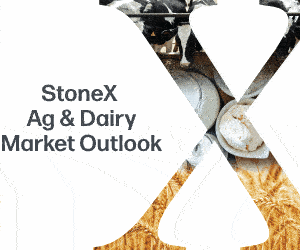 |
|||

|
 |

|
|
Guest Columns
Perspective:
Dairy Markets
The Dr. Jekyll and Mr. Hyde market
Dave Kurzawski
Dave Kurzawski is a senior broker with StoneX Group Inc.*, Chicago, a global financial services firm offering
customized plans and tools to help clients protect margins and manage volatility. He contributes this column exclusively for Cheese Market News®.
 |
 |
Attendees of the popular American Dairy Products Institute (ADPI) conference here in Chicago this weekend are hungry for answers to dairy market questions. They’ll likely get a series of mixed answers.
There’s no shortage of two-sided market stories this year. To name just a few: On-farm dairy profit margins aren’t great, and we’ve added 39,000 cows since December to push the herd to the largest level since August 2021. Global Dairy Trade (GDT) skim milk powder prices are below the long-run price average of US$3,000 per metric ton FAS, and whole milk powder prices are above that level. European Union (EU) traders quip about readying intervention bags, and EU buyers showed more buy-side interest on the last GDT auction event. Chinese buying remains suppressed due to a myriad of factors including their own record-breaking 2022 milk production, and they’ve also stepped up their global purchases recently. The U.S. economy is teetering on the brink of a recession, yet unemployment is at just 3.5%.
The U.S. cheese market specifically has its own chapter of two-side verses. The latest cheese production numbers revealed strong production growth. The growth was driven by Cheddar, which was up 5.6% year-over-year (YoY). February imports were also stronger than expected, up 16.1% from last year. Exports were close to forecast and down 0.4% YoY with Cheddar doing worse than expected but Mozzarella holding up despite EU prices at a big discount in December/January. So, supply (production plus imports) was stronger than expected while exports were neutral — what’s the other side of this story?
Despite the daily rhetoric and worry around recession and curbed spending, cheese demand is strong. The latest domestic disappearance figures were much stronger than anticipated for the first two months of 2023. Strong demand is holding inventories below forecast and down 1.4% from February 2022. And it’s making for some wild market action.
In just the past seven weeks alone the price of both block and barrel cheese at the Chicago Mercantile Exchange (CME) rallied 32 cents and 43.25 cents, respectively, before giving up all of those gains and then some. Markets that swing 30 to 40 cents — both ways — in the span of a few weeks are not entirely stable markets. For lack of a moniker, I’ll call it the strange cheese market of Dr. Jekyll and Mr. Hyde. And, for now, Mr. Hyde is at the helm.
Both block and barrel cheese prices have posted new 2023 low prices here within the last week, shrouding the markets and its participants in a blanket of bearish sentiment. For good measure, we are nearing peak U.S. milk production and — other than in California — key cheese-producing regions are presently showing no sign of letting up on the production side of the equation. To add fuel to the bearish mindset, we’re adding new block cheese capacity later this year as well.
While supply will have cheese buyers sleeping comfortably at night, signs of weaker consumer dairy demand are just not yet showing up. Foodservice is up just 5.2% YoY after adjusting for inflation, and grocery sales are actually falling (-2.7% YoY) after adjusting for inflation.
Should domestic demand remain strong, the real wild card may be on the shoulders of export demand.
Cheddar export demand fell sharply in February as European prices cratered earlier in the year. That story has changed slightly with EU Cheddar prices resurfacing near the $1.90- to $2.00-per-pound price level (Gouda and Mozzarella remain closer to $1.50 per pound). Cheddar in New Zealand fell sharply back in March but has since resurfaced more in line with EU prices. The recent setup appears to put U.S. cheesemakers in the catbird seat for marginal increases in export demand in the next few months.
The nature of mixed data and anecdotal insights in the hallways of the ADPI conference this week will undoubtedly lean more bearish for the price of cheese when all is said and done. Markets are most bearish at the bottom. The difference this year is that such a viewpoint here in late April is quite normal. Historically, cheese price lows are seen this time of year. That hasn’t been the case the last two years, but given the two-sided nature of the market action thus far, it seems a plausible outcome this year.
CMN
*This material should be construed as market commentary, merely observing economic, political and/or market conditions, and not intended to refer to any particular trading strategy, promotional element or quality of service provided by the FCM Division of StoneX Financial Inc. (“SFI”) or StoneX Markets LLC (“SXM”). SFI and SXM are not responsible for any redistribution of this material by third parties, or any trading decisions taken by persons not intended to view this material. Information contained herein was obtained from sources believed to be reliable, but is not guaranteed as to its accuracy. Contact designated personnel from SFI or SXM for specific trading advice to meet your trading preferences. These materials represent the opinions and viewpoints of the author, and do not necessarily reflect the viewpoints and trading strategies employed by SFI or SXM.
| CMN article search |

|
© 2025 Cheese Market News • Quarne Publishing, LLC • Legal Information • Online Privacy Policy • Terms and Conditions
Cheese Market News • Business/Advertising Office: P.O. Box 628254 • Middleton, WI 53562 • 608/831-6002
Cheese Market News • Editorial Office: 5315 Wall Street, Suite 100 • Madison, WI 53718 • 608/288-9090